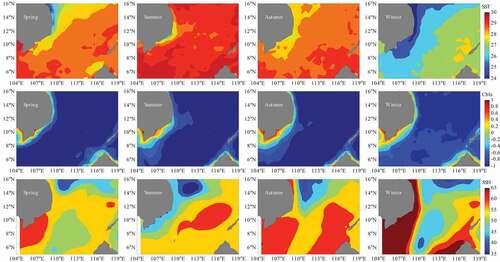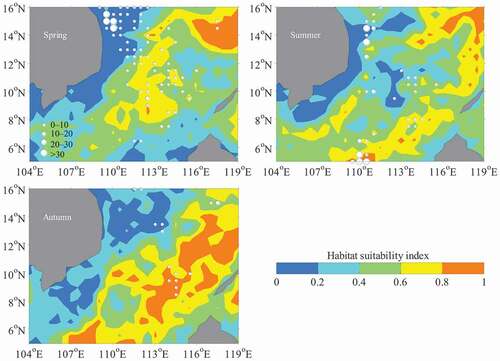 ?Mathematical formulae have been encoded as MathML and are displayed in this HTML version using MathJax in order to improve their display. Uncheck the box to turn MathJax off. This feature requires Javascript. Click on a formula to zoom.
?Mathematical formulae have been encoded as MathML and are displayed in this HTML version using MathJax in order to improve their display. Uncheck the box to turn MathJax off. This feature requires Javascript. Click on a formula to zoom.ABSTRACT
A habitat suitability index model (HSI) was established to examine seasonal habitat pattern of Sthenoteuthis oualaniensis in the South China Sea and assessed the impacts of the El Niño event on habitat variations based on sea surface temperature (SST), chlorophyll-a (Chla) and sea surface height (SSH). Environmental conditions and habitat patterns showed significant seasonal and spatial variations. Spatial pattern of favorable environmental conditions played important roles in regulating the ranges and longitudinal and latitudinal distributions of suitable habitats (areas with HSI≥0.6) of S. oualaniensis across seasons. Significant positive correlation was found between SST and HSI, whereas negative relationship was revealed between HSI and Chla as well as SSH by correlation analysis. Comparing to normal climate condition in spring 2014, the El Niño events in spring 2015 and 2016 yielded lower SST and higher Chla and SSH, which were unfavorable for the formation of high-quality habitats. Favorable ranges of environmental conditions showed decreasing trend from spring 2014 to 2016. Consequently, the suitable habitats in spring 2015 and 2016 largely contracted and became discontinuity. Our findings indicated that seasonal habitat patterns of S. oualaniensis in the South China Sea were strongly affected by the El Niño events and local environmental conditions.
Introduction
The purpleback flying squid Sthenoteuthis oualaniensis, an ommastrephid squid species with fast growth rate, high reproductive capacity and short-lived lifecycle, is predominately distributed in the tropical and subtropical waters between 40°N and 40°S throughout Indo-Pacific regions (Nesis Citation1977; Dong Citation1991). Within the broad habitats in the worldwide oceans, S. oualaniensis has complex population structures. Its mantle length, spawning season, food, and other biology characteristics show large differences with different geographical distribution (Chen, Liu et al. Citation2007; Li et al. Citation2019). As with other ommastrephid squids, S. oualaniensis occupies an important position in the marine ecosystems and food webs, severing as a critical role of connecting large-size marine mammals and small fish as well as zooplankton and phytoplankton (Parry Citation2006, Citation2008). In the South China Sea, S. oualaniensis is one of the most abundant squids and contributes an important fishery for China and other neighboring countries (Fang et al. Citation2013). The population of S. oualaniensis from South China Sea usually performs horizontal and vertical migrations. This squid commonly migrates from offshore waters to coastal regions for breeding from March to May in spring. In the daytime, S. oualaniensis inhabits in the waters at depths deeper than 300 m and moves to the sea surface layer to feed at night (Harman et al. Citation1989; Young and Hirota Citation1998). Due to its high economic values, S. oualaniensis has been commercially exploited by Chinese large-scale light falling-net fishery in the South China Sea (Zhang et al. Citation2010). The stock biomass of S. oualaniensis resources is at 3–4 million tons and 5–7 million tons in the Indian Ocean and in the Pacific Ocean, respectively (Zuyev, Nigmatullin, and Chesalin et al. Citation2002). The estimated stock biomass of S. oualaniensis in the South China Sea is up to 1.5 million tons using acoustic survey data and the logbook data (Zhang et al. Citation2014). Therefore, the S. oualaniensis resources in the South China Sea have important exploitation potentials.
The abundance and spatial distribution of Ommastrephid squids are strongly influenced by large-scale climate variability and regional environmental conditions (Anderson and Rodhouse Citation2001; Yu et al. Citation2015). Various anomalous climatic events occur will quickly induce the changes of local environments on the fishing and spawning grounds of squid species, leading to the spatial shifts of breeding and feeding habitats and abundance variability (Cao, Chen, and Chen Citation2009; Postuma and Gasalla Citation2010). Consequently, squid abundance varies a lot and the locations of fishing ground undergo large movement with the changing environments, and annually squid catches for squid-jigging fisheries from different countries become fluctuant (Sakurai et al. Citation2002; Medellín-Ortiz, Cadena-Cárdenas, and Santana-Morales Citation2016; Igarashia et al. Citation2017). For example, in the western North Pacific Ocean, the neon flying squid Ommastrephes bartramii is dramatically affected by the El Niño-Southern Oscillation (ENSO) and critical environmental factors, such as sea surface temperature (SST), sea surface height anomaly (SSHA), and net primary production (NPP). Under different ENSO conditions, O. bartramii exhibits various densities and spatial distribution pattern. Climate-regulated environmental changes strongly dominate the O. bartramii fisheries in Mainland China, Japan, and Chinese Taipei (Chen, Zhao, and Chen Citation2007; Alabia et al. Citation2016). Additionally, the jumbo flying squid Dosidicus gigas in the Eastern Pacific Ocean has closely linkage with anomalous oceanographic and atmospheric conditions at various spatial and temporal scales. Climate variability, interannual oceanic oscillations and extreme events present a significant impact on D. gigas fisheries in the Gulf of California, Costa Rica, Equator, Peru, and Chile (Waluda, Yamashiro, and Rodhouse Citation2006; Ichii et al. Citation2002; Frawley et al. Citation2019). Given the importance of Ommastrephid squid in the global fisheries, assessing the impacts of changing environments can have significant implications for fisheries management.
The South China Sea is a deep semi-enclosed rhombus-shaped ocean basin and is the largest marginal sea of the western Pacific (Peng et al. Citation2018). It connects with the Pacific Ocean through the Luzon Channel (Nan, Xue, and Yu Citation2015). The local physical, chemical, and biological environmental conditions in the South China Sea are very complex and are associated with the El Niño phenomenon (Wang et al. Citation2006). For S. oualaniensis stock in the South China Sea, most studies focus on its biology characteristics including age, growth, stomach content, population structure, breeding, and so on (Fang et al. Citation2013). Regarding to the relationship between S. oualaniensis stock and marine environments, previous studies have concluded that environmental changes in Xisha-Zhongsha waters present a critical role in regulating spatio-temporal distribution of S. oualaniensis, especially showing strong correlations with SST, Chlorophyll-a concentration (Chla), and sea surface height (SSH) anomaly (Xu et al. Citation2016; Yu et al. Citation2017; Fang et al. Citation2019). However, up to now, seasonal habitat pattern of S. oualaniensis in the South China Sea and its relationships with some critical environmental variables are still unknown. Especially, how the large-scale climate variability such as the El Niño event affects the local environments on the fishing ground and further spatial and temporal distribution of suitable habitats of S. oualaniensis are still unclear. It is essential to evaluate the habitat quality for this squid on a seasonal timescale and connect it to some critical environmental factors.
At the present study, a habitat suitability index (HSI) modeling approach was applied to examine seasonal habitat pattern of S. oualaniensis in the South China Sea from spring to autumn using three critical environmental factors including SST, Chla, and SSH. Suitable habitats of S. oualaniensis were detected for each season and its formation mechanism was explored. The impacts of the El Niño event on habitat variations of S. oualaniensis were also evaluated. The objectives of the present study were to (1) identify the seasonal habitat pattern of S. oualaniensis from spring to autumn; (2) explore the relationship between spatio-temporal distribution of habitat and regional environments; (3) assess the impacts of changing climate conditions (i.e., the El Niño event) on habitat variations of S. oualaniensis in the South China Sea.
Materials and methods
Fisheries and environmental data
The fisheries data of S. oualaniensis in the South China Sea were obtained from the South China Sea Fisheries Research Institute, Chinese Academy of Fishery Sciences. The spatial and temporal resolution of the data was 0.5°× 0.5° and month. All the sampling data located in the main fishing ground between 5°-16°N and 110°-119°E in the offshore waters of South China Sea from 2014 to 2017 (). Data information included fishing time (year and month), fishing location (longitude and latitude) and fishing effort (defined as number of fishing vessels per day). Fishing vessels that applied fishing lamps mainly located in waters with abundant fish, and fishermen were likely to leave when the catch rate decreased, which implied that an area with high fishing efforts indicated the occurrence of a certain suitable habitat for fish species (Chang et al. Citation2018). Thus, fishing effort was used to build the habitat model.
Figure 1. Spatial distribution of fishing effort of Sthenoteuthis oualaniensis in the South China Sea from spring to winter during 2014–2017. The region within the red rectangular box is our study area
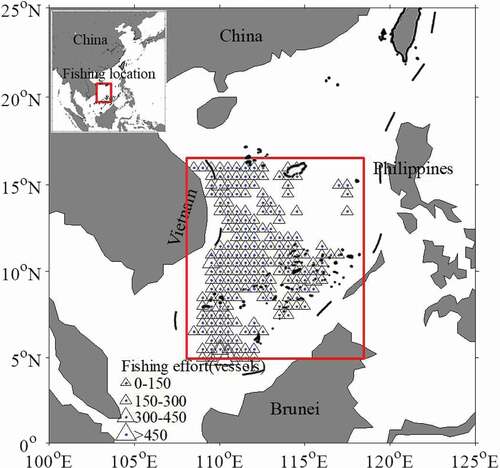
Data was aggregated into seasonal resolution inclusive with spring (March to May), summer (June to August) and autumn (September to November). Most of the Chinese light falling-net fishing vessels targeted S. oualaniensis in the South China Sea had the total tonnage of about 420 t with the length of 40–50 m, the width of 10–15 m and the depth of 4–6 m. Each fishing vessel was equipped with a main engine power of 280 KW × 2 and squid-attracting lamp power of 2000 W × 230. The main size of the net was about 281.60 m × 81.76 m with the maximum mesh size of 35 mm and the minimum mesh size of 20 mm. All the fishing vessels operated at night with few bycatch. In addition, due to winter was not the main fishing time, thus, this season was not included in the analysis in this study.
The environmental variables included SST, Chla, and SSH, which yielded strong impacts on S. oualaniensis abundance and distribution. The monthly SST and Chla concentration data from the Moderate Resolution Imaging Spectroradiometer (MODIS) on board the satellite Aqua platform were obtained from the Asia-Pacific Data Research Center (http://apdrc.soest.hawaii.edu/data/data.php). The MODIS Aqua nighttime SST data was acquired due to all the squid-jigging fishing activity occurred at night. Both SST and Chla Level-3 composite data were from 2014 to 2017 at 9-km of spatial resolution covering the whole fishing ground of S. oualaniensis in the South China Sea. The SSH data were sourced from the eddy-resolving Ocean General Circulation Model for the Earth Simulator (OFES) model (Masumoto et al. Citation2004; Taguchi et al. Citation2007). Spatial and temporal resolution of environmental data was 0.1°× 0.1° grid cell and month, respectively. All the environmental data were compiled into 0.5°× 0.5° and season resolution to match with the fisheries data.
HSI model development, test, and validation
The relationship between fishing efforts from spring-autumn and environmental variables was initially examined using histogram analysis. SST, Chla, and SSH was divided into class interval of 0.3°C, 0.02 mg/m3 and 4 cm, respectively. Based on the total number of fishing efforts in each class interval of different variables, the probability of squid occurrence (referring to the observed suitability index, SI) in various environmental ranges were calculated (Chen et al. Citation2010; Yen, Wang, and Lu Citation2017).
Then, the observed SI values combined with the class interval were applied to fit the SI curves for each environmental variable. The SI models were fitted by the following equations (Yu et al. Citation2016):
where a and b were the model parameters: SST, Chla, and SSH was the value of each class interval. The observed SI was drawn as well as the fitted SI curve to compare the model performance. Each SI model was statistically analyzed. Suitable environmental ranges for S. oualaniensis in the South China Sea were identified as SI>0.6.
The next step was to establish the integrated HSI model for S. oualaniensis in the South China Sea by combining all the SI models based on the Arithmetic Mean Method (AMM). The equation of the HSI model in this study was developed as (Li et al. Citation2014):
where SISST, SIChla, and SISSH were the predicted SI values on the fishing ground for SST, Chla, and SSH, respectively; n was the number of environmental factors in the HSI model. The HSI values ranged from zero to one. Zero indicated the most unfavorable habitats, whereas one indicated the most favorable habitats for S. oualaniensis stock. In addition, the area with HSI≤0.2, with 0.2< HIS <0.6 and with HSI≥0.6 was defined as poor, common, and suitable habitat, respectively, for S. oualaniensis stock in the South China Sea (Yu and Chen Citation2018).
Finally, the HSI model from spring to autumn was tested and validated by the following three steps. First, the fisheries and environmental data from 2014 to 2016 were used to develop the HSI model. All the SI models were statistically evaluated. Second, the actual fisheries data in 2017 were used to validate the HSI model. The predicted HSI values on the fishing ground of S. oualaniensis stock in the South China Sea in 2017 were drawn overlapped with fishing efforts. Third, in order to examine the HSI model performance, the percentage of fishing effort and number of grids were determined within different HSI class interval (0.0–0.2; 0.2–0.4; 0.4–0.6; 0.6–0.8; 0.8–1.0) from spring to autumn.
Seasonal variation of habitat pattern and its relationship with El Niño event
To examine the habitat pattern of S. oualaniensis in the offshore waters in the South China Sea, the HSI values from 2014 to 2017 were predicted and averaged by season, spatial distribution of HSI values in each season was drawn to compare the areas of poor, common, and suitable habitats. The occurrences of suitable habitats of S. oualaniensis by latitude and longitude from spring to autumn during 2014–2017 were further determined to figure out the seasonal spatial variations of favorable habitats. Furthermore, seasonal contour maps of SISST>0.6 overlain with the contour lines of SIChla>0.6 and SISSH>0.6 on the fishing ground of S. oualaniensis were mapped to explore the linkage between the favorable environmental conditions and the range and spatial distribution of the suitable habitats for each season. Spatial correlation analysis was performed between the HSI values and each environmental variable (SST, Chla, and SSH) on the fishing ground, and seasonally spatial distribution of correlation coefficients were also drawn.
The El Niño events significantly affected tropical and subtropical oceanic marine animal habitats (Possamai et al. Citation2018). In order to evaluate the impacts of the El Niño event on potential habitat of S. oualaniensis in the South China Sea, there years (spring 2014, 2015, and 2016) were selected to compare the environmental conditions and habitat patterns. Based on the definition of El Niño from the National Oceanic and Atmospheric Administration (NOAA) Climate Prediction Center (CPC) (https://origin.cpc.ncep.noaa.gov/products/analysis_monitoring/ensostuff/ONI_v5.php), the spring 2014 was a normal climate year, whereas spring 2015 and 2016 were the El Niño years. However, spring 2015 was an El Niño year with very strong intensity, while spring 2016 was El Niño year with relatively weak intensity. Differences in SST, Chla concentration and SSH between 2014 and 2015, and between 2014 and 2016 were initially determined to examine how environmental conditions changed on the fishing ground of S. oualaniensis in the South China Sea under different climate conditions. Then, suitable ranges of SST, Chla, and SSH for 3 years on the basis of suitability index higher than 0.6. Spatial distributions of suitable habitat of S. oualaniensis were finally compared in spring 2014, 2015, and 2016.
Results
Seasonal variations of environmental conditions
Environmental conditions for SST, Chla, and SSH on the fishing ground of S. oualaniensis in the South China Sea exhibited significant seasonal variations (). It was observed that SST was the highest in summer and the lowest in winter. And SST in the coastal waters off Vietnam was lower relative to the waters in the high seas for each season. Especially in spring and winter, the waters were lower than 25°C in the nearshore areas off Vietnam. Chla was relatively high in winter comparing to other seasons. Additionally, the Chla density in the coastal regions was much higher than that in the open seas. Regarding to SSH, it was high in spring, summer and autumn, and low in the winter. Waters with much lower SSH concentrated in the northern regions on the fishing ground of S. oualaniensis in comparison with the southern regions from spring to winter.
Analysis of HSI models
The SI curve for each environmental factor (SST, Chla, and SSH) was statistically evaluated and drawn in . It was found that most SI models from spring to autumn had low Root Mean Square Errors (RMSE) and high correlation coefficient, indicating that the fitted SI models exhibited good model performance and could truly reflect squid-environment relationships. The suitable and optimal SST, Chla, and SSH ranges for S. oualaniensis showed dramatically seasonal variations.
Figure 3. Seasonal fitted suitability index (SI) curves inferred from the associations between fishing effort and sea surface temperature (SST), Chlorophyll-a (Chla) concentration and sea surface height (SSH) from spring to autumn over 2014–2016

The percentages of fishing occurrence and number of grids under each HSI class interval from spring to winter were shown in using data during 2014–2016. Within the HSI class interval between 0.0 and 0.2 (i.e., the poor habitat of S. oualaniensis), the fishing efforts and grids accounted for the lowest percentages in the three seasons. Most fishing efforts occurred in the normal and suitable habitats with the HSI class interval higher than 0.2. The suitable habitat (HSI higher than 0.6) yielded the highest fishing efforts, suggesting that most fishing operations occurred in the favorable habitats.
Figure 4. The percentage of fishing occurrence and number of grids under each habitat suitability index (HSI) class interval from spring to winter using data during 2014–2016
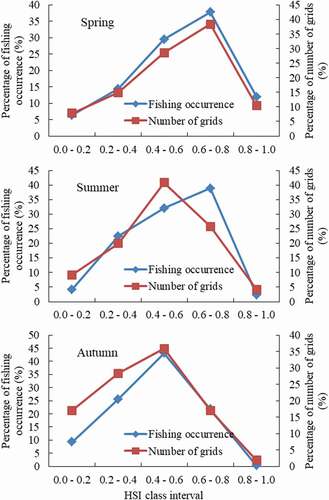
The HSI values from spring to autumn in 2017 were predicted and overlaid with the actual fishing efforts (). Clearly, most fishing efforts were distributed in the regions with higher HSI values, especially in the waters with HSI>0.6. In spring 2017, only small percentages of fishing efforts occurred in the western regions of the fishing ground. Based on the above-mentioned analyses, it indicated that the HSI model in this study could yield reliable prediction capacity due to the well consistency between spatial distribution of fishing effort and fishing activity and the quality of the habitat.
Spatial and temporal variations in S. oualaniensis habitats
Habitat patterns of S. oualaniensis in the South China Sea showed significant seasonal and spatial variations in spring, summer and autumn (). The poor habitats mainly occurred in spring and summer, and were largely distributed in the coastal waters of Vietnam. In autumn, very few low-quality habitats located in the fishing ground. Relative to the suitable habitat, its range was highest in spring, followed by autumn and lowest in summer. In spring, suitable habitats were mostly bounded within two geographical regions between 5°-13°N, 108°-116°E (the northern part) and between 13°-16° and 113°-119°E (the southern part). However, the suitable habitats in summer became discontinuity, particularly the southern part of favorable habitats contracted and shifted southeastward relative to the spring. Suitable habitats in autumn further moved to the southeastern regions, but its range relatively enlarged.
Figure 6. Seasonal distribution of the average habitat suitability index (HSI) on the fishing ground of Sthenoteuthis oualaniensis in the South China Sea from spring to autumn during 2014–2017
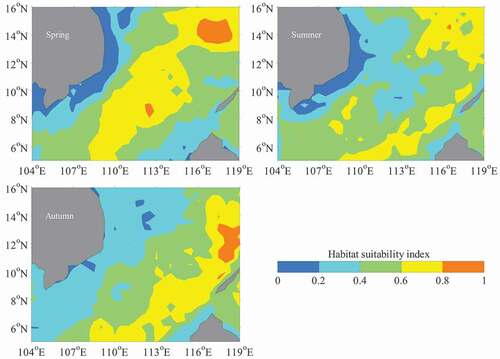
The longitudinal and latitudinal distributions of suitable habitats from spring to autumn were shown in . Suitable habitats were extensively distributed in the latitude between 4.5°-16.0°N and in the longitude between 107.0°-119.5°E but with seasonal variations. The occurrence of suitable habitats by latitude was divided into southern and northern parts with 12°N as the boundary line. Comparing to the summer and autumn, most suitable habitats occupied the southern waters on the fishing ground in spring. With respect to the longitudinal distribution, suitable habitats were largely located in the eastern waters of 108°E. However, favorable habitats of S. oualaniensis in spring mostly concentrated in the area between 109°E and 115°E, then shifted eastward in the regions between 113.5°E and 119.5°E.
Figure 7. The occurrence of suitable habitats (HSI>0.6) of Sthenoteuthis oualaniensis in the South China Sea from spring to autumn during 2014–2017 in relation to the latitude (Upper panel) and longitude (Lower panel)
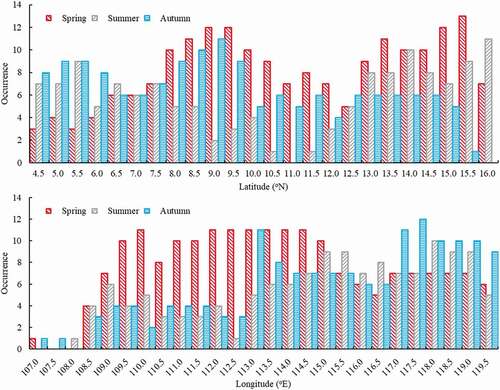
The spatial distributions of favorable SST, Chla, and SSH were exhibited in on the fishing ground of S. oualaniensis in the South China Sea. The suitable SST was extensively distributed from spring to autumn, while the suitable Chla range was large in spring and low in summer and autumn. In addition, favorable SSH was obviously divided into northern and southern parts in spring and summer. It was clear that the spatio-temporal pattern of the overlapping regions by the three favorable environmental conditions were consistent with the distribution of suitable habitats of S. oualaniensis. Moreover, significant positive correlation was found between SST and HSI, whereas negative relationship was revealed between HSI and Chla as well as SSH on the main fishing ground of S. oualaniensis on the basis of spatial correlation analysis ().
Figure 8. Seasonal contour maps of SI_SST>0.6 (suitability index of sea surface temperature (SI_SST) higher than 0.6) overlain with the contour lines of SI_Chla>0.6 (suitability index of Chlorophyll-a (SI_Chla) higher than 0.6) and SI_SSH>0.6 (suitability index of sea surface height (SI_SSH) higher than 0.6) on the fishing ground of Sthenoteuthis oualaniensis from spring to autumn in the South China Sea
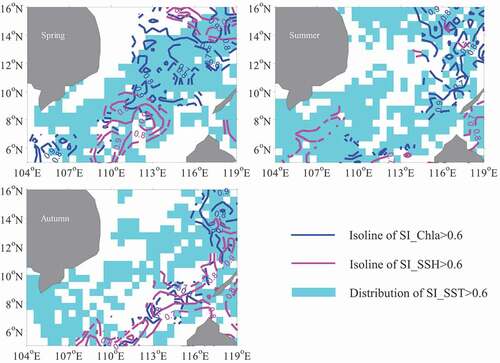
Figure 9. Seasonally spatial distribution of correlation coefficients between the habitat suitability index (HSI) on the fishing ground of Sthenoteuthis oualaniensis and sea surface temperature (SST), Chlorophyll-a (Chla) concentration and sea surface height (SSH), respectively, from spring to autumn in the South China Sea
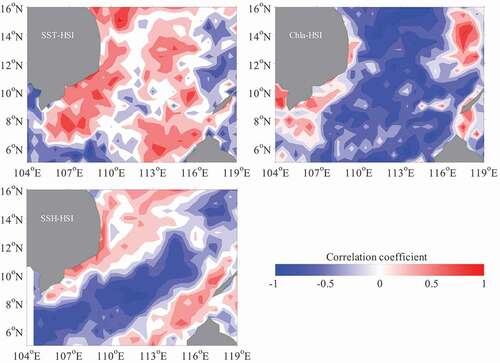
Impacts of the El Niño event on S. oualaniensis habitats
Large difference was found in the environmental conditions between 2014 and 2015, and between 2014 and 2016 (). Comparing to normal climate condition in spring 2014, the El Niño events in spring 2015 yielded much lower SST. The SST in spring 2016 was a little bit higher than that in 2014. Both Chla and SSH in 2015 and 2016 were much higher than those in 2014, which were unfavorable for the formation of high-quality habitats for S. oualaniensis. Furthermore, it was observed that the favorable ranges of each environmental variable, especially the suitable SST areas, expanded in spring 2014 comparing to the two years (). Consequently, the quality of habitat was high in 2014, but was relatively low in 2015 and 2016. Further, the suitable habitats of S. oualaniensis in spring 2014 enlarged, however, it largely contracted and became discontinuity in spring 2015 and 2016 ().
Figure 10. Differences in sea surface temperature (SST) (Uppper panel), Chlorophyll-a (Chla) concentration (Middel panel) and sea surface height (SSH) (Lower paner) between 2014 and 2015 in spring (Left panel), and between 2014 and 2016 in spring (Right panel)
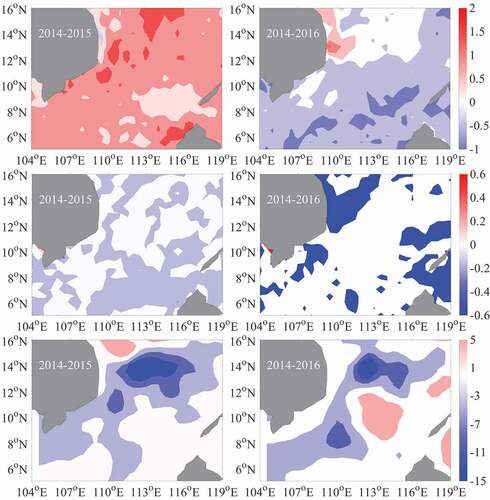
Figure 11. Suitable ranges of sea surface temperature (SST), Chlorophyll-a (Chla) concentration and sea surface height (SSH) for Sthenoteuthis oualaniensis in spring 2014 (the year with normal climate condition), 2015 (the El Niño year with very strong intensity) and 2016 (the El Niño year with weak intensity), based on the suitability index higher than 0.6
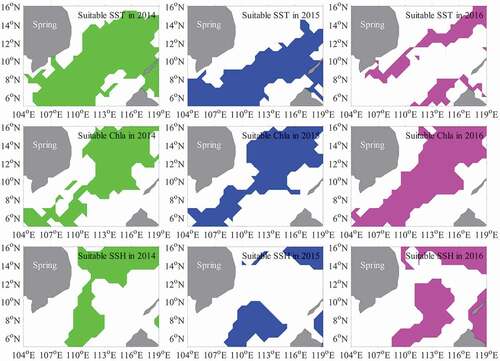
Figure 12. Spatial distribution of suitable habitat (habitat suitability index higher than 0.6) of Sthenoteuthis oualaniensis in spring 2014 (the year with normal climate condition), 2015 (the El Niño year with very strong intensity) and 2016 (the El Niño year with weak intensity) in the South China Sea

Discussion
Habitat modeling approach has been widely applied to examine species-habitat relationship, identify habitat hotspots and evaluate the impacts of climate variability and oceanographic conditions on spatio-temporal of habitat pattern for pelagic fish species (Tanaka and Chen Citation2016; Yi et al. Citation2017; Yu et al. Citation2019). However, the model prediction performance largely depends on the model inputs, structure, and other factors (Gong et al. Citation2011; Xue et al. Citation2017). Therefore, the HSI model accuracy and reliability should be carefully evaluated. Regarding to the HSI model in this study, some issues on the HSI model should be clarified.
First, the selection of SST, Chla, and SSH as the input variables of the HSI model was based on their significant influences on S. oualaniensis stock in the South China Sea. Many studies supported the conclusions that the above-mentioned three factors played an important role in regulating the abundance and distribution of S. oualaniensis (Xu et al. Citation2016; Yu et al. Citation2017, Citation2019a; Fang et al. Citation2019). S. oualaniensis was a warm water and temperature-sensitive oceanic squid species, its habitat range and distribution was closely associated with SST (Xu et al. Citation2016). Chla concentration could be regarded as a critical index to indicating the food availability and distribution of S. oualaniensis (Yu et al. Citation2017). As an ocean’s dynamic environmental parameter, SSH could reflect various warm-cold water mass and eddy structure, affecting the formation of S. oualaniensis fishing ground (Fang et al. Citation2013, Citation2019). Therefore, the three crucial variables were chosen to establish the HSI model.
Second, the relationship between fishing effort of S. oualaniensis and each environmental factor was employed to determine the SI values. The fishing effort was not randomly distributed, it followed the distribution range of suitable habitats with high abundance of fish population. Therefore, this study applied the fishing effort to construct the HSI model and predict the probability of squid occurrence with three key environmental factors. Previous studies also stated that fish effort could be used to estimate the SI for other pelagic fish species such as Pacific saury Cololabis saira in the Northwest Pacific Ocean (Hua et al. Citation2020) and chub mackerel Scomber Japonicus in the East China Sea (Li et al. Citation2014). For Chinese squid fisheries, large amounts of fishing efforts in a certain area implied lots of fishing vessels concentrated in fishing ground with abundant squids, namely, this area might be a suitable habitat for the targeted squid species (Chen, Liu, and Chen Citation2008). In addition, CPUE-based (catch per unit effort) HSI model performance was ever compared with fishing effort-based HSI model, results suggested the former model underestimated squid habitat quality, while the latter model yielded reliable habitat prediction ability (Tian et al. Citation2009). Thus, fishing effort was a better proxy to determine the SI than CPUE.
Third, different environmental factors contributed various influences to habitat variations of S. oualaniensis in the South China Sea. In fact, their importance commonly was different (Fang et al. Citation2016). There was one conclusion that SST was the most important factor, followed by Chla and SSH, for S. oualaniensis (Yu et al. Citation2019bb). Actually, it was very difficult to quantify their importance using the fisheries data with finite time series and limited research area (Gong et al. Citation2011). Therefore, the empirical arithmetic average method was considered as the best method to determine the ultimate HSI value, which showed obvious superior relative to other methods, such as continued product model or maximum/minimum model (Li et al. Citation2014; Silva et al. Citation2016). And the HSI model was tested and validated by three methods, our model has good model performance and yield reliable predictions for the habitat suitability for S. oualaniensis.
Fourth, due to the limited in data period and CPUE information, some uncertainties might be occurred in this analysis. For example, the HSI model should be compared between CPUE-based model and fishing effort-based model to improve the reliability and accuracy of the habitat prediction. By cooperating with other institutions or countries, future studies should involve more detailed fisheries data of S. oualaniensis with long-term time series to develop a comprehensive HSI model and clarify the impacts of the El Niño/La Niña events with different intensity.
Marine species habitat quality and distribution pattern on monthly, seasonal and interannual scale exhibited affinity to regional environmental variations. For example, spatial and temporal variability of habitat distribution of American lobster Homarus americanus presented large difference in spring and autumn off coastal waters of New Hampshire and Maine. Habitat suitability showed increasing trend for both sexes and stages (juvenile and adult) in the spring, while no significant trend was observed in the autumn (Tanaka and Chen Citation2016). Off Chile, geographic distribution of jack mackerel Trachurus murphyi habitat also showed seasonal variations and varied from year to year. Changes in the latitudinal gravity center of fishing ground of T. murphyi were consistent with latitudinal distribution of suitable habitat (Li et al. Citation2016). For short-lived squids such as O. bartramii in the western Pacific and D. gigas in the Eastern Pacific, environmental-related variability of habitat patterns on different scales were highly coincided with variations in CPUE and fishing ground distributions (Yu et al. Citation2019, Citation2020).
Habitat patterns of S. oualaniensis in the South China Sea including suitable and optimal range of each environmental variable, the ranges of poor/suitable habitat and their longitudinal and latitudinal distributions showed significant seasonal variations from spring to autumn. Firstly, the suitable range of SST was high in summer and low in spring and autumn. Generally, the near-surface waters were relatively warm in summer due to the low latitude and the equatorial current-driven warm waters into the South China Sea (Fang et al. Citation2016; Yu et al. Citation2019a, Citation2019b). With the season shifted, suitable Chla for S. oualaniensis was low in summer and relatively higher in spring and autumn, whereas the suitable ranges of SSH increased from spring to autumn. Then, the habitat quality of S. oualaniensis was poor in the coastal waters of the South China Sea during the three seasons, especially in spring and summer. S. oualaniensis was a pelagic squid species and preferred to inhabit in relatively deep waters rather than shallow areas (Fang et al. Citation2013). Besides, most of the fishing operations for S. oualaniensis occurred in the offshore waters, which might lead to the model biases. Third, seasonal changes in the range and spatial distribution of suitable habitats could be largely explained by the environmental changes of the three variables. The formation of suitable habitats for each season was driven by the overlapping areas of the favorable environmental conditions by the three variables. It was observed that the overlapping areas decreased in summer, thus, the range of suitable habitat of S. oualaniensis contracted in this season. Besides, the migration of suitable habitat in the longitudinal and latitudinal directions from spring to autumn was in accordance with the shift of preferred SSH and Chla (i.e., areas with SI_SSH>0.6 and SI_Chla>0.6). Squid usually preferred to inhabit in the areas with favorable environmental conditions. Once the environments surrounding the original habitat became unsuitable, squids would move to another more suitable habitat (Yu et al. Citation2015). Therefore, the southeastward shift of favorable environments for S. oualaniensis from spring to autumn determined the similar movement pattern of suitable habitat.
Significant associations were found between habitat quality of S. oualaniensis and environmental variables. Based on the relationships, it suggested that relatively warmer SST and lower Chla and SSH could yield higher habitat suitability of S. oualaniensis in this study. Previous study ever employed generalized additive model (GAM) to evaluate the relationship between the spring CPUE of S. oualaniensis in Xisha-Zhongsha waters of the South China Sea and environmental factors (Yu et al. Citation2019a). They stated that SST within the range of 24–28.5°C had a positive effect on S. oualaniensis CPUE. The majority of S. oualaniensis stock was mainly distributed in waters with Chla ranging from 0.05 to 0.15 mg/m3. CPUE generally increased with the Chla when the density was lower than 0.2 mg/m3. However, the relationship between Chla and CPUE shifted into negative when Chla density was higher than 0.2 mg/m3. In addition, linearly negative relation was found between S. oualaniensis CPUE and SSH anomaly. These conclusions were consistent with our findings. It was important note that squid generally preferred high prey density, but negative relationship was revealed between HSI and Chla in this study. This was not imply that the higher the Chla concentration, the better the squid habitat quality. Because S. oualaniensis inhabited the waters with specific suitable range of Chla. Based on previous studies, the suitable range of Chla was about 0.1–0.13 mg/m3 (Yu et al. Citation2017), which was consistent with our studies (see ). Though negative relationship was found between the Chla and HSI, however, the areas with enlarged suitable range of Chla, it was found that the HSI in this area would be high.
It is well known that climate variability presents an emerging challenge to the exploitation and sustainable management of squid fisheries in the worldwide oceans (Arkhipkin et al. Citation2020). In the Pacific Ocean, the El Niño and La Niña phenomena are important drivers of interannual variations of climate and marine ecosystems (Schwing et al. Citation2002). Recent spatial and temporal variations of habitat hotspots for ommastrephid squid species are ascribed with high confidence to the El Niño/La Niña-driven regional environmental changes, such as O. bartramii and D. gigas (Chen et al. Citation2007; Alabia et al. Citation2016; Yu et al. Citation2016). But the impacts of the El Niño/La Niña events can be shown not only in the Pacific Ocean but also off the coastal waters of China. For example, the El Niño events were closely associated with biological and physical environmental changes in the East China Sea, dominating the habitat variations of S. Japonicus (Yu et al. Citation2018).
Detailed information about the impacts of the El Niño/La Niña events on S. oualaniensis in the South China Sea is scarce. Only two studies have reported that the La Niña event in early spring 2008 significantly affected temperature and feeding environments of S. oualaniensis, resulting in variations of squid stock size and fishing ground distribution (Yu et al. Citation2019a, Citation2019b). In this study, the impacts of the El Niño event on S. oualaniensis in the South China Sea were first estimated. Our finding revealed that such a climatic phenomenon played profound influences on habitat patterns of this squid. Relative to normal climate condition in spring 2014, the El Niño events in spring 2015 and 2016 led to relatively cold water and high Chla and SSH. Due to the positive relationship between SST and HSI, and negative relationship between HSI and Chla as well as SSH, the environmental conditions under the El Niño conditions were unfavorable for squid growth and inhabitation and further the formation of high-quality habitats for S. oualaniensis, which consequently yielded contracted relatively low-quality of habitats in 2015 and 2016, and the range of suitable habitats largely contracted and became discontinuity. Although the El Niño event yielded a negative effect on habitat quality of S. oualaniensis, but the impacts showed difference because of the different intensity of El Niño events in the two years. A strong El Niño event occurred in spring 2015, but the intensity was weak in spring 2016. Therefore, it was found that the SST in 2016 was relatively higher than that in 2015, and the habitat quality was better in this year. The gigantic El Niño event yielded significant impacts on global fisheries. For example, the strong El Niño event occurred in 2015 dramatically changed the habitat patterns, abundance, and distribution of S. Japonicus in the East China Sea, O. bartramii in the Northwest Pacific Ocean and D. gigas in the Southeast Pacific Ocean (Guo et al. Citation2018; Chen et al. Citation2020; Wen et al. Citation2020). All the fishing efforts combined with the fishing vessels decreased as well as the catch in this year.
In summary, environmental conditions and habitat patterns of S. oualaniensis in the South China Sea showed significant seasonal and spatial variations. Spatial pattern of favorable environmental conditions played an important role in regulating the ranges and longitudinal and latitudinal distributions of suitable habitats (area with HSI≥0.6) of S. oualaniensis across seasons. Comparing to normal climate condition in spring 2014, the El Niño events in spring 2015 and 2016 yielded relatively lower SST and higher Chla and SSH, which were unfavorable for the formation of high-quality habitats for S. oualaniensis. Our findings suggested that seasonal habitat patterns of S. oualaniensis in the South China Sea were closely associated with local environmental conditions on the fishing ground. Importantly, the El Niño events strongly affected spatio-temporal variations of S. oualaniensis habitat.
Disclosure of potential conflicts of interest
No potential conflict of interest was reported by the author(s).
Acknowledgments
This study was financially supported by the Major Projects of Basic and Applied Basic Research Programs in Guangdong Province (2019B030302004); Key Special Project for Introduced Talents Team of Southern Marine Science and Engineering Guangdong Laboratory (GML2019ZD0605); Key research and development project of Guangdong Province (2020B1111030001); Central Public-Interest Scientific Institution Basal Research Fund (2020TD05 and 2021 SD01).
Data availability statement
Data available on request from the authors.
Correction Statement
This article has been republished with minor changes. These changes do not impact the academic content of the article.
References
- Alabia, I. D., S. I. Saitoh, T. Hirawake, H. Igarashi, Y. Ishikawa, N. Usui, M. Kamachi, T. Awaji, and M. Seito. 2016. “Elucidating the Potential Squid Habitat Responses in the Central North Pacific to the Recent ENSO Flavors.” Hydrobiologia 772 (1): 215–15. doi:https://doi.org/10.1007/s10750-016-2662-5.
- Anderson, C. I. H., and P. G. Rodhouse. 2001. “Life Cycles, Oceanography and Variability: Ommastrephid Squid in Variable Oceanographic Environments.” Fisheries Research 54 (1): 133–143. doi:https://doi.org/10.1016/S0165-7836(01)00378-2.
- Arkhipkin, A. I., L. C. Hendrickson, I. Payá, G. J. Pierce, R. H. Roa-Ureta, J. P. Robin, and A. Winter. 2020. “Stock Assessment and Management of Cephalopods: Advances and Challenges for Short-lived Fishery Resources.” ICES Journal of Marine Science. doi:https://doi.org/10.1093/icesjms/fsaa038.
- Cao, J., X. J. Chen, and Y. Chen. 2009. “Influence of Surface Oceanographic Variability on Abundance of the Western Winter-spring Cohort of Neon Flying Squid Ommastrephes Bartramii in the NW Pacific Ocean.” Marine Ecology Progress Series 381: 119–127. doi:https://doi.org/10.3354/meps07969.
- Chang, Y. J., K. W. Lan, W. A. Walsh, and J. Hsu. 2018. “Modelling the Impacts of Oceanographic Variation on Habitat Suitability for Pacific Saury in the Northwestern Pacific Ocean.” Fisheries Oceanography 28 (3): 1–14.
- Chen, H. H., X. X. Wu, J. T. Fan, W. Yu, X. J. Chen, and W. G. Qian. 2020. “Impacts of the Strong 2015 El Niño Event on Ommastrephes Bartramii Fishing Grounds in the Northwest Pacific Ocean.” Journal of Fishery Sciences of China 27 (10): 1243–1253.
- Chen, X. J., B. L. Liu, and Y. Chen. 2008. “A Review of the Development of Chinese Distant-water Squid Jigging Fisheries.” Fisheries Research 89 (3): 211–221. doi:https://doi.org/10.1016/j.fishres.2007.10.012.
- Chen, X. J., B. L. Liu, S. Q. Tian, W. G. Qian, and X. H. Zhao. 2007. “Fishery Biology of Purpleback Squid, Sthenoteuthis Oualaniensis, in the Northwest Indian Ocean.” Fisheries Research 83 (1): 98–104. doi:https://doi.org/10.1016/j.fishres.2006.09.005.
- Chen, X. J., S. Q. Tian, Y. Chen, and B. L. Liu. 2010. “A Modeling Approach to Identify Optimal Habitat and Suitable Fishing Grounds for Neon Flying Squid (Ommostrephes Bartramii) in the Northwest Pacific Ocean.” Fishery Bulletin 108 (1): 1–14.
- Chen, X. J., X. H. Zhao, and Y. Chen. 2007. “Influence of El Niño/La Niña on the Western Winter-spring Cohort of Neon Flying Squid (Ommastrephes Bartramii) in the Northwestern Pacific Ocean.” ICES Journal of Marine Science 64 (6): 1152–1160. doi:https://doi.org/10.1093/icesjms/fsm103.
- Dong, Z. Z. 1991. The Biology of Oceanic Economic Cephalopod in the World, 17–19. Vol. 94. Jinan: Shangdong Science Press.
- Fang, J. T., Z. Z. Chen, J. Zhang, and X. Feng. 2016. “Sthenoteuthis Oualaniensis Fishing Grounds Analysis Based on Marine Environmental Factors and Different Weight Coefficients in the Zhongxisha and Xisha Islands, South China Sea.” South China Fisheries Science 12 (4): 57–63.
- Fang, J. T., X. Feng, Y. S. Qiu, Z. R. Huang, and G. B. Chen. 2013. “Review on the Biology of Purpleback Flying Squid in South China Sea.” Journal of Agriculture Sciences of Guangdong 23: 122–128.
- Fang, J. T., J. Zhang, X. Feng, and Z. Z. Chen. 2019. “Relationship between Sthenoteuthis Oualaniensis Fishing Ground and Marine Environmental Factors in Nansha Area.” Journal of Shanghai Ocean University 28 (3): 419–426.
- Frawley, T. H., D. K. Briscoe, P. C. Daniel, G. L. Britten, L. B. Crowder, C. J. Robinson, and W. F. Gilly. 2019. “Impacts of a Shift to a Warm-water Regime in the Gulf of California on Jumbo Squid (Dosidicus Gigas).” ICES Journal of Marine Science 76 (7): 2413–2426.
- Gong, C. X., X. J. Chen, F. Gao, W. J. Guan, and L. Lei. 2011. “Review on Habitat Suitability Index in Fishery Science.” Journal of Shanghai Ocean University 20 (2): 260–269.
- Guo, A., Y. Zhang, W. Yu, X. J. Chen, W. G. Qian, and Y. S. Li. 2018. “Influence of ElNiño and LaNiña with Different Intensity on Habitat Variation of Chub Mackerel Scomber Japonicus in the Coastal Waters of China.” Acta Oceanologica Sinica 40 (12): 58–67.
- Harman, R. F., R. E. Young, S. B. Reid, K. M. Mangold, T. Suzuki, and R. F. Hixon. 1989. “Evidence for Multiple Spawning in the Tropical Oceanic Squid Sthenoteuthis Oualaniensis (Teuthoidea: Ommastrephidae).” Marine Biology 101 (4): 513–519. doi:https://doi.org/10.1007/BF00541653.
- Hua, C. X., F. Li, Q. C. Zhu, G. P. Zhu, and L. Meng. 2020. “Habitat Suitability of Pacific Saury (Cololabis Saira) Based on a Yield-density Model and Weighted Analysis.” Fisheries Research 221: 105408. doi:https://doi.org/10.1016/j.fishres.2019.105408.
- Ichii, T., K. Mahapatra, T. Watanabe, A. Yatsu, D. Inagake, and Y. Okada. 2002. “Occurrence of Jumbo Flying Squid Dosidicus Gigas Aggregations Associated with the Countercurrent Ridge off the Costa Rica Dome during 1997 El Niño and 1999 La Niña.” Marine Ecology Progress Series 231: 151–166. doi:https://doi.org/10.3354/meps231151.
- Igarashia, H., T. Ichii, M. Sakai, Y. Ishikawa, T. Toyoda, S. Masuda, N. Sugiura, K. Mahapatra, and T. Awaji. 2017. “Possible Link between Interannual Variation of Neon Flying Squid (Ommastrephes Bartramii) Abundance in the North Pacific and the Climate Phase Shift in 1998/1999.” Progress in Oceanography 150: 20–34. doi:https://doi.org/10.1016/j.pocean.2015.03.008.
- Li, B., X. F. Yang, X. Y. Qiu, J. X. Wang, B. H. Zhou, J. Y. Xie, and Y. R. Yan. 2019. “Discriminant Analysis of Purpleback Flying Squid (Sthenoeuthis Oualaniensis) Groups Based on Statolith Morphology in the South China Sea.” Journal of Guangdong Ocean University 39 (2): 58–66.
- Li, G., J. Cao, X. R. Zou, X. J. Chen, and J. Runnebaum. 2016. “Modeling Habitat Suitability Index for Chilean Jack Mackerel (Trachurus Murphyi) in the South East Pacific.” Fisheries Research 178: 47–60. doi:https://doi.org/10.1016/j.fishres.2015.11.012.
- Li, G., X. J. Chen, L. Lei, and W. J. Guan. 2014. “Distribution of Hotspots of Chub Mackerel Based on Remote-sensing Data in Coastal Waters of China.” International Journal of Remote Sensing 35 (11–12): 4399–4421. doi:https://doi.org/10.1080/01431161.2014.916057.
- Masumoto, Y., H. Sasaki, T. Kagimoto, N. Komori, A. Ishida, Y. Sasai, T. Miyama, et al. 2004. “A Fifty-year Eddy-resolving Simulation of the World Ocean: Preliminary Outcomes of OFES (OGCM for the Earth Simulator).” Journal of Earth Simulator 1: 35–56.
- Medellín-Ortiz, A., L. Cadena-Cárdenas, and O. Santana-Morales. 2016. “Environmental Effects on the Jumbo Squid Fishery along Baja California’s West Coast.” Fisheries Science 82 (6): 851–861. doi:https://doi.org/10.1007/s12562-016-1026-4.
- Nan, F., H. J. Xue, and F. Yu. 2015. “Kuroshio Intrusion into the South China Sea: A Review.” Progress in Oceanography 137: 314–333. doi:https://doi.org/10.1016/j.pocean.2014.05.012.
- Nesis, K. N. 1977. “Population Structure in the Squid Sthenoteuthis Oualanienses (Lessonn 1930) (Ommastrephidae) in the Western Tropical Pacific.” In: Proceedings of the Academy of Science USSR, Shirsch Inst. Oceanol., vol. 107, pp. 15–29. Širšova.
- Parry, M. 2006. “Feeding Behavior of Two Ommastrephid Squids Ommastrephes Bartramii and Sthenoteuthis Oualaniensis off Hawaii.” Marine Ecology Progress Series 318 (1): 229–235. doi:https://doi.org/10.3354/meps318229.
- Parry, M. 2008. “Trophic Variation with Length in Two Ommastrephid Squids, Ommastrephes Bartramii and Sthenoteuthis Oualaniensis.” Marine Biology 153 (3): 249–256. doi:https://doi.org/10.1007/s00227-007-0800-3.
- Peng, H. B., A. J. Pan, Q. A. Zheng, and J. Y. Hu. 2018. “Analysis of Monthly Variability of Thermocline in the South China Sea.” Journal of Oceanology and Limnology 36 (2): 205–215. doi:https://doi.org/10.1007/s00343-017-6151-0.
- Possamai, B., J. P. Vieira, A. M. Grimm, and A. M. Garcia. 2018. “Temporal Variability (1997-2015) of Trophic Fish Guilds and Its Relationships with El Niño Events in a Subtropical Estuary.” Estuarine, Coastal and Shelf Science 202: 145–154. doi:https://doi.org/10.1016/j.ecss.2017.12.019.
- Postuma, F. A., and M. A. Gasalla. 2010. “On the Relationship between Squid and the Environment: Artisanal Jigging for Loligo Plei at São Sebastião Island (24°S), Southeastern Brazil.” ICES Journal of Marine Science 67 (5): 1353–1362. doi:https://doi.org/10.1093/icesjms/fsq105.
- Sakurai, Y., H. Kiyofuji, S. I. Saitoh, J. Yamamoto, T. Goto, K. Mori, and T. Kinoshita. 2002. “Stock Fluctuations of the Japanese Common Squid, Todarodes Pacificus, Related to Recent Climate Changes.” Fisheries Science 68 (sup1): 226–229. doi:https://doi.org/10.2331/fishsci.68.sup1_226.
- Schwing, F. B., T. Murphree, L. deWitt, and P. M. Green. 2002. “The Evolution of Oceanic and Atmospheric Anomalies in the Northeast Pacific during the El Niño and La Niña Events of 1995-2001.” Progress in Oceanography 54 (1–4): 459–491.
- Silva, C., I. Andrade, E. Yáñez, S. Hormazabal, M. Á. Barbieri, A. Aranis, and G. Böhm. 2016. “Predicting Habitat Suitability and Geographic Distribution of Anchovy (Engraulis Ringens) Due to Climate Change in the Coastal Areas off Chile.” Progress in Oceanography 146: 159–174. doi:https://doi.org/10.1016/j.pocean.2016.06.006.
- Taguchi, B., S. P. Xie, N. Schneider, M. Nonaka, H. Sasaki, and Y. Sasai. 2007. “Decadal Variability of the Kuroshio Extension: Observations and an Eddy-resolving Model Hindcast.” Journal of Climate 20 (11): 2357–2377. doi:https://doi.org/10.1175/JCLI4142.1.
- Tanaka, K., and Y. Chen. 2016. “Modeling Spatio-temporal Variability of the Bioclimate Envelope of Homarus Americanus in the Coastal Waters of Maine and New Hampshire.” Fisheries Research 177: 137–152. doi:https://doi.org/10.1016/j.fishres.2016.01.010.
- Tian, S. Q., X. J. Chen, Y. Chen, L. X. Xu, and X. J. Dai. 2009. “Evaluating Habitat Suitability Indices Derived from CPUE and Fishing Effort Data for Ommatrephes Bartramii in the Northwestern Pacific Ocean.” Fisheries Research 95 (2): 181–188. doi:https://doi.org/10.1016/j.fishres.2008.08.012.
- Waluda, C. M., C. Yamashiro, and P. G. Rodhouse. 2006. “Influence of the ENSO Cycle on the Light-fishery for Dosidicus Gigas in the Peru Current: An Analysis of Remotely Sensed Data.” Fisheries Research 79 (1–2): 56–63. doi:https://doi.org/10.1016/j.fishres.2006.02.017.
- Wang, C., W. Wang, D. Wang, and Q. Wang. 2006. “Interannual Variability of the South China Sea Associated with El Niño.” Journal of Geophysical Research 111: C03023. doi:https://doi.org/10.1029/2005JC003333.
- Wen, J., M. T. Qian, W. Yu, X. J. Chen, and B. L. Liu. 2020. “Habitat Variations of the Jumbo Flying Squid Dosidicus Gigas off Peru under El Niño and La Niña Events with Different Intensities.” Journal of Fishery Sciences of China 27 (9): 1095–1103.
- Xu, H. Y., X. S. Cui, W. F. Zhou, G. B. Chen, and A. Z. Ni. 2016. “Analysis on Optimal Habitats of Purpleback Flying Squid in the Open South China Sea Based on Remote Sensing Data.” Chinese Journal of Ecology 35 (11): 3080–3085.
- Xue, Y., L. Guan, K. Tanaka, Z. Li, Y. Chen, and Y. Ren. 2017. “Evaluating Effects of Rescaling and Weighting Data on Habitat Suitability Modeling.” Fisheries Research 188: 84–94. doi:https://doi.org/10.1016/j.fishres.2016.12.001.
- Yen, K. W., G. Wang, and H. J. Lu. 2017. “Evaluating Habitat Suitability and Relative Abundance of Skipjack (Katsuwonus Pelamis) in the Western and Central Pacific during Various El Niño Events.” Ocean & Coastal Management 139: 153–160. doi:https://doi.org/10.1016/j.ocecoaman.2017.02.011.
- Yi, Y., X. Cheng, Z. Yang, S. Wieprecht, S. Zhang, and Y. Wu. 2017. “Evaluating the Ecological Influence of Hydraulic Projects: A Review of Aquatic Habitat Suitability Models.” Renewable and Sustainable Energy Reviews 68: 748–762. doi:https://doi.org/10.1016/j.rser.2016.09.138.
- Young, R. E., and J. Hirota 1998. “Review of the Ecology of Sthenoteuthis Oualaniensis near the Hawaiian Archipelago.” Okutani, International Symposium on Large Pelagic Squids, 113–143. Tokyo, Japan.
- Yu, J., Q. Hu, D. Tang, H. Zhao, and P. Chen. 2019a. “Response of Sthenoteuthis Oualaniensis to Marine Environmental Changes in the North-central South China Sea Based on Satellite and in Situ Observations.” PLoS ONE 14 (1): e0211474. doi:https://doi.org/10.1371/journal.pone.0211474.
- Yu, J., Q. W. Hu, C. H. Li, P. Zhang, and J. M. Mao. 2017. “Relationship between the Sthenoteuthis Oualaniensis Resource and Environmental Factors in Xisha-Zhongsha Waters in Spring.” Acta Oceanologica Sinica 39 (6): 72–83.
- Yu, J., Q. W. Hu, D. L. Tang, and P. M. Chen. 2019b. “Environmental Effects on the Spatiotemporal Variability of Purpleback Flying Squid in Xisha-Zhongsha Waters, South China Sea.” Marine Ecology Progress Series 623: 25–37. doi:https://doi.org/10.3354/meps13026.
- Yu, W., and X. J. Chen. 2018. “Ocean Warming-induced Range-shifting of Potential Habitat for Jumbo Flying Squid Dosidicus Gigas in the Southeast Pacific Ocean off Peru.” Fisheries Research 204: 137–146. doi:https://doi.org/10.1016/j.fishres.2018.02.016.
- Yu, W., X. J. Chen, Q. Yi, and S. Q. Tian. 2015. “A Review of Interaction between Neon Flying Squid (Ommastrephes Bartramii) and Oceanographic Variability in the North Pacific Ocean.” Journal of Ocean University of China 14 (4): 739–748. doi:https://doi.org/10.1007/s11802-015-2562-8.
- Yu, W., X. J. Chen, Y. Zhang, Q. Yi, and A. Arkhipkin. 2019. “Habitat Suitability Modelling Revealing Environmental-driven Abundance Variability and Geographical Distribution Shift of Winter–spring Cohort of Neon Flying Squid Ommastrephes Bartramii in the Northwest Pacific Ocean.” ICES Journal of Marine Science 76 (6): 1722–1735. doi:https://doi.org/10.1093/icesjms/fsz051.
- Yu, W., A. Guo, Y. Zhang, X. J. Chen, W. G. Qian, and Y. S. Li. 2018. “Climate-induced Habitat Suitability Variations of Chub Mackerel Scomber Japonicus in the East China Sea.” Fisheries Research 207: 63–73. doi:https://doi.org/10.1016/j.fishres.2018.06.007.
- Yu, W., J. Wen, Z. Zhong, X. J. Chen, and Y. Zhang. 2020. “Spatio-temporal Variations in the Potential Habitat of a Pelagic Commercial Squid.” Journal of Marine Systems 206: 103339. doi:https://doi.org/10.1016/j.jmarsys.2020.103339.
- Yu, W., Q. Yi, X. J. Chen, and Y. Chen. 2016. “Modelling the Effects of Climate Variability on Habitat Suitability of Jumbo Flying Squid, Dosidicus Gigas, in the Southeast Pacific Ocean off Peru.” ICES Journal of Marine Science: Journal Du Conseil 73 (2): 239–249. doi:https://doi.org/10.1093/icesjms/fsv223.
- Zhang, J., Z. Z. Chen, G. B. Chen, Y. S. Qiu, S. G. Liu, and S. Yao. 2014. “Hydroacoustic Detection and Estimation Techniques of Squid Sthenoteuthis Oualaniensis in the South China Sea.” South China Fisheries Science 10 (6): 1–11.
- Zhang, P., L. Yang, X. F. Zhang, and Y. G. Tang. 2010. “The Present Status and Prospect on Exploitation of Tuna and Squid Fishery Resources in South China Sea.” South China Fisheries Science 6 (1): 68–74.
- Zuev, G., C. Nigmatullin, M. Chesalin et al. 2002. “Main Results of Long-term Worldwide Studies on Tropical Nektonic Oceanic Squids Genus Sthenoteuthis: An Overview of the Soviet Investigations.” Bulletin of Marine Science 71 (2): 1019–1060.

